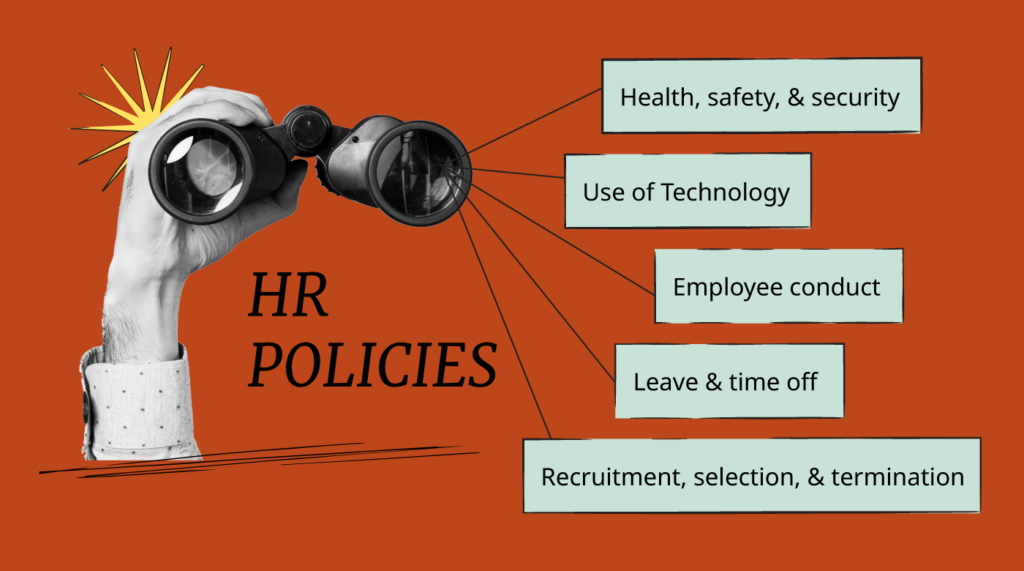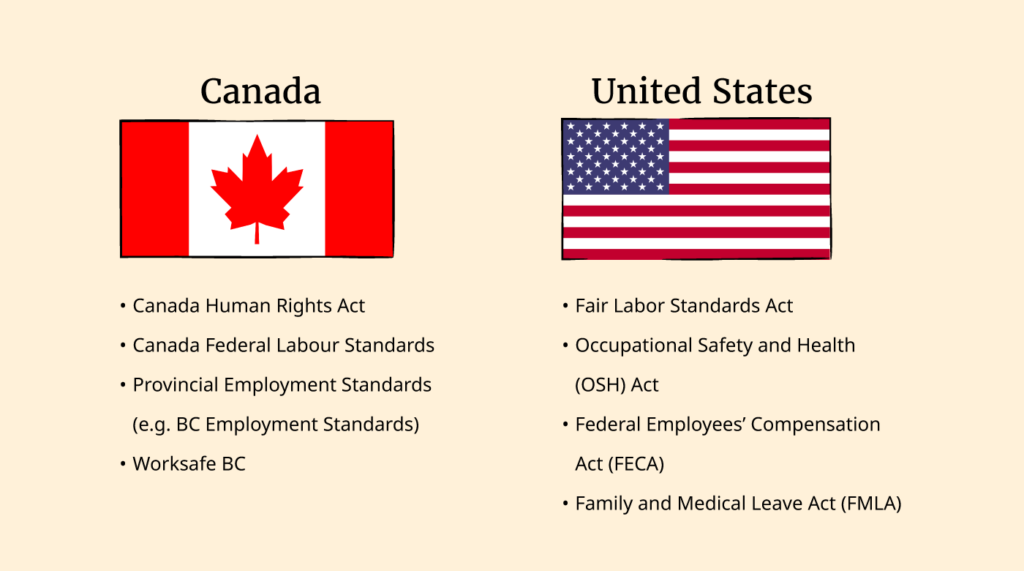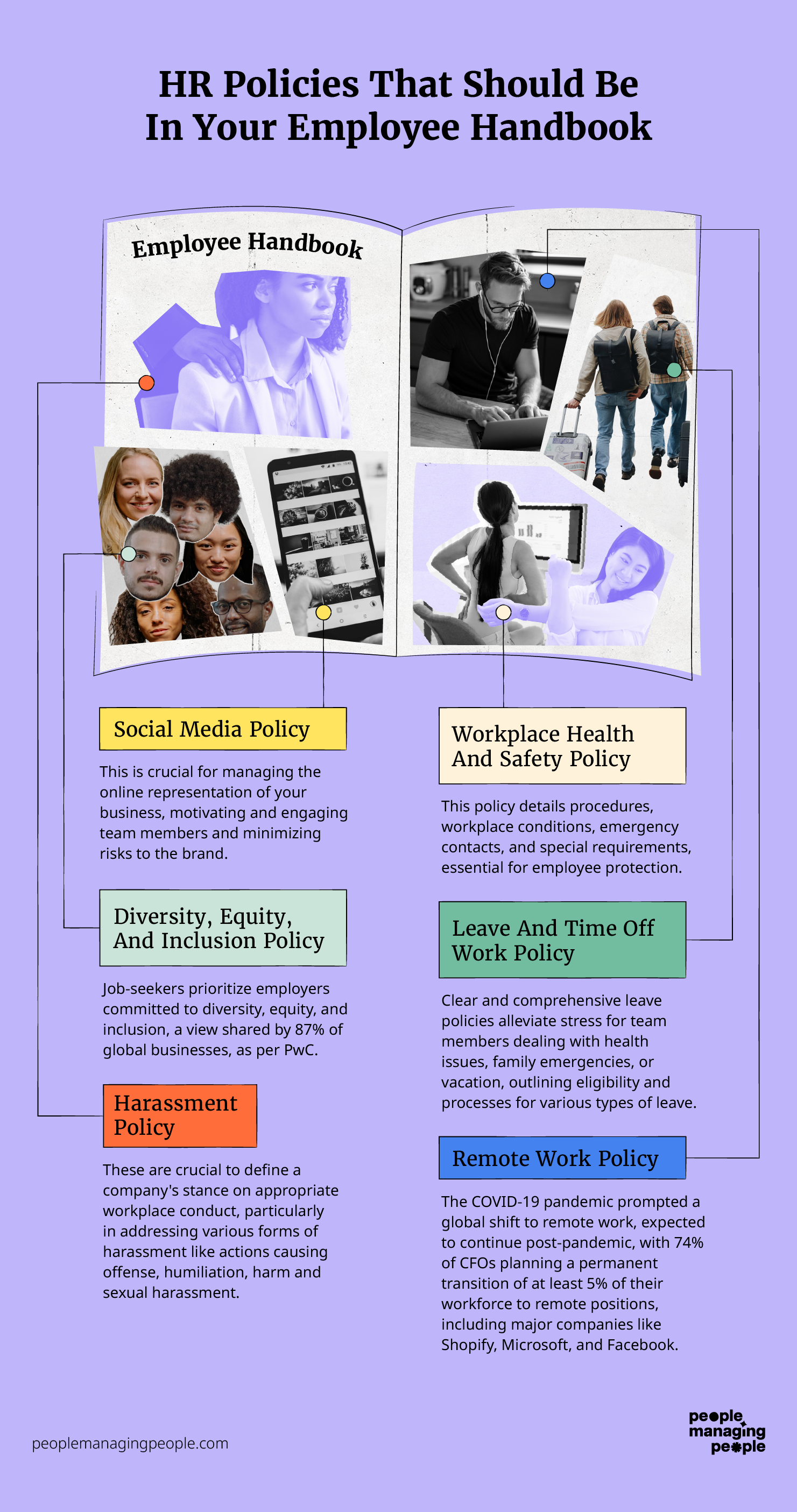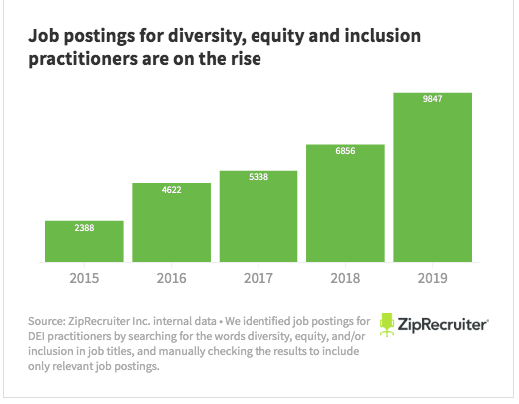When any startup or small business expands, the human resource management challenges you face become increasingly complex.
As more and more people join the organization, it becomes harder and harder to ensure consistency and manage employee issues on a case-by-case basis. The solution is to create some company policies.
This article is going to help you do exactly that—providing you with an overview of human resource policies and procedures, complete with examples.
Let's start with the basics.
What Are HR Policies?
Human resource policies are rules and processes that govern the employment relationship between the employer and employee. Policy creation is one of the core HR pillars.
Why Are HR Policies Important?
HR policies are an important part of how your business is structured and regulated to ensure compliance and actions consistent with culture. Some benefits of HR policies include:
- Describe the rights and responsibilities of both employers and employees
- Guide employees and leaders, clarifying expected behaviors
- Help promote a happy and healthy workplace
- Provide a framework for resolving disputes and grievances
- Help streamline various HR processes
- Help remain compliant with laws and regulations.
Who Manages HR Policies?
An organization’s human resources team (or whoever is responsible for HR activities) is often responsible for creating and maintaining HR policies. Most HR policies apply to all permanent, temporary, part-time, and full-time employees.
In tandem with the HR policy creation, you'll need a document management platform or an HR policy management system to help the HR team maintain, manage, and process detailed employee information, human resources documents, policies, and procedures.
HR teams can use HR case management systems to monitor compliance with company policies and resolve issues effectively.
HR Policy Types
There are many types of HR policies and procedures that a business (and its employees) may benefit from implementing over time, such as health and safety, security, use of technology, employee conduct, leave, recruitment and selection, and termination.

Here are some more detailed examples of HR Policies:
| HR Policy Area | Specific HR Policy Examples |
|---|---|
| Recruitment and Selection | Diversity, Equity, and Inclusion Hiring Practices Promotions and Transfers |
| Leave and Time Off | Vacation Statutory Holidays Family Leave Parental Leave Bereavement Leave Medical / Sick Leave Personal Leave of Absence Jury Duty |
| Health, Safety, and Security | Health and Safety Workplace Violence Drugs and Alcohol Smoking COVID-19 Protocols |
| Employee Conduct | Harassment Sexual Harassment Conflict of Interest Confidentiality and Non-Disclosure Time and Attendance Meal and break Bring your own device Working hours Remote working Dress Code Weapon-free workplace |
| Performance Management | Performance Management Professional Development At-Will Employment Termination Disciplinary Action |
| Use of Technology | Computer Usage and Security Personal Devices at Work Work-Related and Personal Use of Social Media Data privacy |
| Work Travel | Travel Authorization Expense Reimbursement Hotel and Rental Car Meals and Per Diems Remote Work |
11 Benefits of HR Policies
HR (Human Resources) policies can play a crucial role in the effective management of an organization as it scales. Here are some of the benefits to consider.
- Consistency and Fairness: HR policies ensure that all employees are treated fairly and consistently which helps maintain a sense of justice and equality that’s important for employee morale and satisfaction.
- Clear Guidelines: These policies provide clear guidelines for decision-making and expected behavior. This clarity helps in reducing confusion and misunderstandings among employees and management.
- Legal & Regulatory Compliance: HR policies help organizations comply with local and international labor laws, providing legal protection not just for the company but also for its employees—crucial to avoid legal issues and fines.
- Improved Efficiency: Standardized policies streamline various HR processes like recruitment, onboarding, and performance evaluations which can lead to improved efficiency.
- Conflict Resolution: They provide a framework for addressing and resolving workplace issues and conflicts. This helps in maintaining a harmonious work environment.
- Risk Management: Well-defined HR policies help in mitigating risks related to employment issues. They provide guidelines on how to handle sensitive matters like harassment, discrimination, and employee grievances.
- Performance Management: HR policies aid in setting clear performance standards and provide a basis for evaluating employee performance. This contributes to the overall productivity of the organization.
- Organizational Culture: Policies help in shaping the culture of an organization. They set expectations for behavior and interactions, which can foster a positive and productive work environment.
- Employee Development: Policies related to training and development ensure that employees have opportunities to learn and grow, which can increase job satisfaction and retention.
- Recruitment and Retention: Clear HR policies can make an organization more attractive to potential employees. They also play a role in retaining staff by ensuring fair treatment and providing a clear path for growth and development.
- Enhancing Employee Engagement: Policies that focus on employee well-being, diversity, and inclusion can enhance employee engagement and commitment to the organization.
HR policies are foundational to the smooth and efficient operation of an organization as it grows and changes. They provide the structure to effectively manage people in a happy, productive, and legally compliant workplace.
Potential Downsides of HR Policies to Consider
Your HR policies can potentially backfire if they’re not properly written, implemented, or managed.
Here are some potential pitfalls to look out for.
- Over-regulation and bureaucracy: Excessive HR policies can create a rigid, bureaucratic work environment, stifling creativity and innovation, and leading to inefficiencies and frustration due to slow decision-making processes.
- One-size-fits-all approach: Standardized policies may fail to address the unique needs of different departments or individuals, leading to dissatisfaction and reduced effectiveness in addressing specific challenges.
- Resistance to change: Employees may resist policies they view as overly restrictive or unnecessary, particularly if implemented without sufficient communication or consideration of employee feedback, leading to a lack of buy-in and potential conflicts.
- Negative impact on morale and employer brand: Strict or punitive policies can harm employee morale and the organization's reputation as an employer, potentially making it difficult to attract and retain top talent.
- Legal and compliance risks: Poorly drafted, outdated, or non-compliant policies can lead to legal challenges and HR compliance issues, posing significant risks to the organization.
To mitigate these downsides, it's important for organizations to:
- Regularly review and update their HR policies
- Ensure they are clearly communicated and understood
- Maintain a balance between necessary regulation and flexibility.
Involving employees in the development of these policies can also help in ensuring that they are well-received and relevant to the needs of the workforce.
Is An HR Policy The Same As A Corporate Policy Or Guideline?
The terms “HR policy”, “corporate policy”, “company policy”, and “workplace policy” are often used interchangeably and refer to the same thing.
However, some corporate policies may apply to more general operations of the organization, and may be created and maintained by a department other than HR (e.g., facility access, computer security, disaster preparation, etc.).
Policies are a set of rules, not guidelines.
According to HR Expert Tim Reitsma, “When I hear the word policy, it can be read as a restrictive word. But if we replace “policy” with “guideline”, unfortunately, it doesn’t hold the weight that needs to be there.”
Where Are HR Policies Usually Found?
A key part of a new hire checklist and orientation program is to review, together with the employee, the specific policies that could impact them on their first day or in their first week.
HR policies may exist as written policies, as digital and/or printable policies, and in locations that are easily accessible by employees.
They may be saved within the HR software, or sometimes within a company intranet or shared drives. They are often found in employment contracts, employee handbooks, and company policy manuals. However, the level of detail in each of these will vary.
Why Aren’t All HR Policies Included In The Employment Contract?
Your company’s employment contract might define how much vacation a team member is entitled to, while a separate vacation policy would describe how an employee can request vacation, how it’s approved, what happens if it’s not all used, etc.
The separation ensures that the employment contract isn’t overly long and complex. It also enables you to customize certain aspects of an individual’s employment, such as how much vacation leave they’ll receive (employment contract), and keep this separate from the general leave policy (staff manual).
Documenting policies outside the employment contract also allows policies to be updated over time, without updating each individual’s agreement.
It's also helpful to offer a condensed version of your employee handbook specifically for new hires, to avoid overloading them with too much information right from day one.

When Should You Develop Human Resource Policies?
Some HR policies might be determined by organization needs, or when certain aspects of the employment relationship become too difficult to handle on a case-by-case basis.
Other policies should be developed proactively to help guide, empower, or protect employees; bring clarity to organizational issues; or protect the broader interests of the organization.
Here are some general guidelines on when you should create HR policies.
Create Policies Directly Related To The Employment Contract
A good place to start is by creating policies that are directly related to employee benefits and the rights and responsibilities of both the employee and the employer, as outlined in the employment contract.
For example, many employment contracts will specify vacation eligibility, various types of leave benefits, and how the employment relationship can be terminated (e.g., at-will employment).
Related HR policies would go into deeper detail on the procedures related to these things.
Refer to the section below for some examples to help you understand how policy implementation differs between the employment contract and the employee handbook.
Create Policies Required By Employment Laws
When in doubt, use the applicable laws (provincial/state laws, federal laws) and common labor relations practices as another starting point to creating the policy.
There are many pieces of employment legislation in both Canada and the USA that set out the minimum requirements of employers with respect to many of these policies, such as:

Create Policies That Will Positively Impact Employees And The Organization
Joerg Clement, a senior leader in the machine vision industry, summarizes it best:
“Implementing processes and policies is the foundation of an organization’s commitment to continual improvement. Customer and employee requirements and expectations evolve over time. It is important to be able to respond to changes in markets quickly, and that comes from aligning your processes and policies to achieve successful outcomes.”
Focus on those HR policies that have the greatest positive impact on employees and the organization. When considering a new policy, ask yourself these questions:
- How will this policy empower and protect employees?
- How will it create a strong and high-performing workplace culture?
- Are the organizational values and principles supported?
- How does this policy help us create a successful and cohesive team?
- Will this policy minimize risks to the business?
- Will this policy satisfy applicable legal requirements?
If you answered “yes” to all of these questions, it's likely a policy worth creating!
What HR Policies Should Be In Your Employee Handbook?
You’ll need to create written policies directly related to the employment contract or required by employment law.

The following six policies can positively impact full-time and part-time employees, and the organizations that implement them.
- Diversity, Equity, And Inclusion Policy
- Harassment Policy
- Remote Work / Telecommuting Policy
- Social Media Policy
- Workplace Health And Safety Policy
- Leave And Time Off Work Policy
When in doubt, use labor laws, other applicable laws (local laws, provincial / state laws, federal laws), and common labor relations practices as a starting point
For example, employment legislation like the Family and Medical Leave Act (FMLA) and the Americans With Disabilities Act in the United States, and the Employment Standards Act of BC in Canada, set out the minimum requirements of employers with respect to many of these policies.
Diversity, Equity, And Inclusion Policy
The push toward workplace equality, whether it’s race or gender equality, has never been greater. Given recent worldwide protests against systemic racism and movements like Black Lives Matter, it should also be at the top of your mind.
Most research, such as this study from Glassdoor, shows that job-seekers want to know that prospective employers care about diversity, equity, and inclusion.
According to PwC, 87% of global businesses say diversity and inclusion is an organizational priority.

Job postings requesting practitioners in diversity, equity, and inclusion have become more prevalent in recent years.
Job site companies Glassdoor and ZipRecruiter recognize this, with Glassdoor launching new products designed to help create more equitable workplaces. They recognize that creating a comprehensive policy and program, and making it public, can make the difference when hiring top talent.
Salesforce has a Chief Equality Officer, which demonstrates their commitment to equality and their support at the most senior levels of leadership, and their “Equality for All” policy is available on their website, describing their values and beliefs in equal rights, equal pay, equal education, and equal opportunity.
Harassment Policy
Like diversity, equity, and inclusion, policies against harassment have never been more important.
The purpose of a harassment policy, like this one from Google, is to outline your company’s position regarding appropriate and respectful conduct in the workplace and reinforce the responsibilities of all parties in achieving and maintaining a positive work environment.
According to the Canada Labour Code, harassment and violence is defined as:
"Any action, conduct or comment, including of a sexual nature, that can reasonably be expected to cause offence, humiliation or other physical or psychological injury or illness to an employee, including any prescribed action, conduct or comment."
Sexual harassment is one of the most common forms of harassment. The #MeToo movement has brought to light many serious issues and the significant harm that harassment and violence can have on people.
As a result, consider having a separate company policy, or section within a more general policy, to address sexual harassment.
A good harassment policy will also cover other types of harassment, including racial slurs, physical threats, and derogatory jokes.
Remote Work / Telecommuting Policy
The COVID-19 coronavirus has caused a crisis of global proportions, impacting individuals, businesses, and world economies.
As a result, many businesses have chosen to adopt work from home (WFH) and remote work policies to help manage through this crisis.
It’s expected that this trend will continue beyond the current pandemic. A March 2020 survey of CFOs by Gartner, Inc. revealed that 74% of respondents will move at least 5% of their previously on-site workforce to permanently remote positions post-COVID-19.Big companies like Shopify, Microsoft, and Facebook are permanently shifting more employees to work from home. Canada-based Shopify has even posted many of their remote work systems strategies on their website.

A remote work HR policy, like this example provided by Remote.co, should include:
- Company history of remote work
- Who is eligible for remote work
- How often / long a team member can work remotely
- How to request a remote work arrangement
- Communication protocols and standards with team members
- Tools, equipment, and resources needed to support remote work.
Social Media Policy
Social media is an important component of any digital marketing strategy. How your business is represented online, by you and your team members, can mean the difference between brand success and failure.
Setting some rules for team members around how they use social media, both personally and professionally, minimizes risks to your business, your brand, and the motivation and engagement of your team members.
No one wants to be embarrassed about the organization they work for because of the social media activities of a co-worker.
Most HR policies are “living policies”; they need to be regularly updated and kept relevant. That said, social media HR policies generally need to be updated more often than most, due to the constantly changing social media landscape.
Vancouver-based Hootsuite, a social media management platform, offers some excellent guidelines for developing your own social media policy, as well as a helpful social media policy template.
Workplace Health And Safety Policy
An occupational health and safety policy, such as this one from Lyft, will often outline procedures, workplace conditions, emergency contact information, and other special requirements (e.g., COVID-19 safety protocols) needed to protect employees.
Organizations such as the US Department of Labor’s Occupational Safety and Health Administration (OSHA) also require certain minimum standards be in place to protect the well-being of employees.
Workplace violence is directly related to employee health, safety, and security, but typically has its own separate policy.
For example, Disney’s employee policy manual has an entire section dedicated to health, safety, and security, and includes a workplace violence policy.
Leave And Time Off Work Policy
The reality is that people occasionally need time away from work to deal with health issues or family emergencies, or just to go on vacation somewhere tropical!
Having clear and comprehensive leave policies can help your team members by removing the stress of knowing how you will support them through difficult times, such as those faced with the COVID-19 coronavirus.
These human resources policies outline employees’ eligibility for leave and the processes by which they take it. These policies are separate from the HR information systems that track employee leaves, but both the system and the policy need to match.
Here are some of the different types of leave policies you should consider creating, in rough order of priority. (Note that all of these types of leave have associated employment laws that set out minimum requirements).

Types of Leave Policies
- Statutory Holidays: government-recognized holidays like Thanksgiving and Christmas
- Vacation: scheduled time away from work to rest and relax
- Medical / Sick Leave: time away from work due to illness or hospitalization
- Family Leave: related to the care, health, or education of a family member
- Parental Leave: time for a birth parent to care for a newborn
- Bereavement Leave: related to the death of a family member
- Leave of Absence: extended, unpaid time away from work for personal reasons.
Leave policies can also be somewhat controversial, depending on how they’re implemented. The next section on “policies to avoid” will talk about what to avoid when creating leave policies.
So that's what you should be including in your employee handbook. Many companies choose to use employee handbook software to help with creating, updating, and disseminating theirs.
Which Policies Should You Avoid Including In Your Employee Handbook?
In addition to those policies that are important and necessary to include in your employee handbook, it’s also important to know which ones could negatively impact your company culture, demotivate employees, or dissuade potential employees from joining.
You should avoid creating policies that are too bureaucratic and rigid, don’t demonstrate trust in your team members, or are simply outdated and no longer relevant in modern, people-focused, and progressive organizations.
Following are some HR policies that you should leave out entirely, or approach with caution when it comes time to define them.
Strict Dress Code

There are some situations where dress guidelines are still appropriate e.g. at customer meetings or trade shows, but in general, the days are gone when it was OK for a company to dictate the color of a person’s trousers, or whether they could wear jeans or not.
Mary Barra, the CEO of General Motors, reduced the automaker’s 10-page dress code to just two words that apply to most organizations: “dress appropriately”.
Inflexible Time Off
Provide your salaried employees with flexibility when they need to take a bit of time here and there to attend a doctor’s appointment, or go to a parent-teacher interview.
Unlike hourly employees, you don’t need to make them track every hour that they work and don’t work, like credit and debit entries on a bank account.
Mistrustful Bereavement Leave
“Hmm, so did your grandma really die?” That’s the last thing any of us would want to hear after a devastating personal loss, but that’s exactly what you’re asking if you implement a bereavement leave policy that requires proof of death, like a death certificate.
Many progressive organizations also offer their employees paid bereavement leave, so that they don’t need to take precious vacation time (which should be spent resting and relaxing) or sick time to deal with a family crisis.
Personal Cell Phone And Internet Usage
Human resource policies that prohibit employees from using personal mobile phones at work, or using work computers to access the internet for personal use, are rapidly becoming outdated.
Psychology research has shown that taking breaks at work is necessary to maintain energy, motivation, and focus.
Taking a walk, doing some stretching, or meditating are all great ways to take a mental break.
If the weather isn't accommodating, surfing the internet, cruising social media, or chatting with a friend outside of work are also good alternatives.
Of course, doing too much of these things isn’t ok, but these cases are usually rare, and can be dealt with one on one with your team member.
And… Remember The Importance Of Clarity, Language, And Tone
Keep in mind that policies, no matter how positive their intent, can still be perceived as authoritarian and bureaucratic.
How your policies are written and presented can therefore have a big impact on how they’re received by the people in your organization, and on the organizational culture you’re trying to develop.
Carla Nordean, Director of People and Culture at Squirrel Systems, notes: “The overall tone of the handbook has a huge impact on the culture. If your handbook is worded with oppressive language ("employees must / must not..."), new hires may question whether they've joined the right organization.”
Tim Reitsma adds: “The language we use in our organizations matters when we write policies. There are some that are 'you must”, but we can soften the language to be something like, “you are responsible for”.”
How to Write Your HR Policies
Writing effective HR policies involves a thoughtful process that considers the specific needs of your organization, compliance with laws and regulations, and best practices in HR management.
Here's a step-by-step guide to help you write HR policies:
1. Identify the Need
- Start by identifying the areas within your organization that require formalized policies. This could be driven by legal requirements, organizational needs, or employee feedback.
2. Research
- Research relevant laws and regulations to ensure compliance
- Look into industry standards and best practices
- Review policies from similar organizations for insights.
3. Consult stakeholders
- Engage with various stakeholders including management, employees, and possibly legal advisors to gather input and understand different perspectives
4. Draft the policy
Use this format to help you draft the policy.
- Title: Clearly state what the policy is about.
- Purpose: Explain why the policy is being implemented and its importance.
- Scope: Define who the policy applies to (e.g., all employees, certain departments).
- Policy Statement: Outline the organization's stance or rules regarding the specific issue.
- Procedures: Detail the steps or procedures employees and management need to follow related to the policy.
- Responsibilities: Specify the responsibilities of different stakeholders (employees, HR, managers) under the policy.
- Enforcement: Explain how the policy will be enforced and the consequences of non-compliance.
- Review and Modification: Mention how and when the policy will be reviewed and updated.
6. Review and Revise
- Have the draft reviewed by HR professionals and legal counsel to ensure it meets legal requirements and organizational goals.
- Revise the policy based on feedback received.
7. Approve and distribute
- Obtain approval from top management.
- Communicate the policy to all employees through appropriate channels (e.g., email, company intranet, staff meetings).
- Offer training sessions if the policy requires changes in behavior or processes.
8. Implement and Monitor
- Implement the policy and monitor its effectiveness.
- Be prepared to address questions and provide clarification as needed.
9. Regular Review and Update
- Regularly review the policy to ensure it remains relevant and compliant with laws and regulations.
- Update the policy as necessary, informing employees of significant changes.
Best Practices For Writing HR Policies
1. Align with organizational goals and values
- Ensure that each policy aligns with your organization's mission, vision, and core values. Policies should support the overall strategic objectives and improve the culture of the organization.
2. Be clear and concise
- Use simple, straightforward language. Avoid legal jargon or complex terms that might confuse employees. The goal is to make the policies as clear and accessible as possible to ensure understanding and compliance.
3. Ensure legal compliance
- Make sure your policies comply with all relevant local, state, and federal laws and regulations. This may require consulting with legal professionals or HR experts to avoid any legal issues.
4. Involve stakeholders in the development process
- Engage a diverse group of stakeholders, including employees from different levels and departments, in the policy development process. This helps ensure the policies are realistic, practical, and address the needs and concerns of the entire workforce.
5. Keep it flexible
- While policies should provide clear guidelines, they also need to allow for some flexibility to accommodate exceptional circumstances. Being too rigid can create unnecessary constraints and hinder effective decision-making.
6. Focus on the employee experience
- Consider how policies will impact the employee experience. Policies should be fair, promote a positive work environment, and support employee well-being.
7. Provide examples
- Where applicable, include examples to clarify the policy's application. This can help prevent misunderstandings and illustrate how the policy should be interpreted in practical situations.
8. Outline responsibilities and consequences
- Clearly define who is responsible for what under each policy, as well as the consequences of non-compliance. This accountability framework helps ensure the policy is taken seriously and adhered to.
9. Communicate and train
- Once developed, communicate the policies effectively to all employees. Consider training sessions or workshops to ensure everyone understands the policies and how they apply to their roles.
10. Review and update regularly
- Regularly review your HR policies to ensure they remain relevant, effective, and legally compliant. Update them as necessary, especially when there are changes in laws, organizational structure, or strategic objectives.
11. Ensure accessibility
- Make sure all employees have easy access to the policies, whether through an intranet, employee handbook, or another accessible format.
12. Promote transparency and open communication
- Encourage feedback on the policies and maintain an open-door policy for questions or concerns related to HR policies. This promotes a culture of transparency and continuous improvement.


